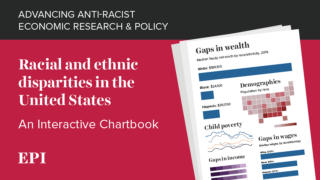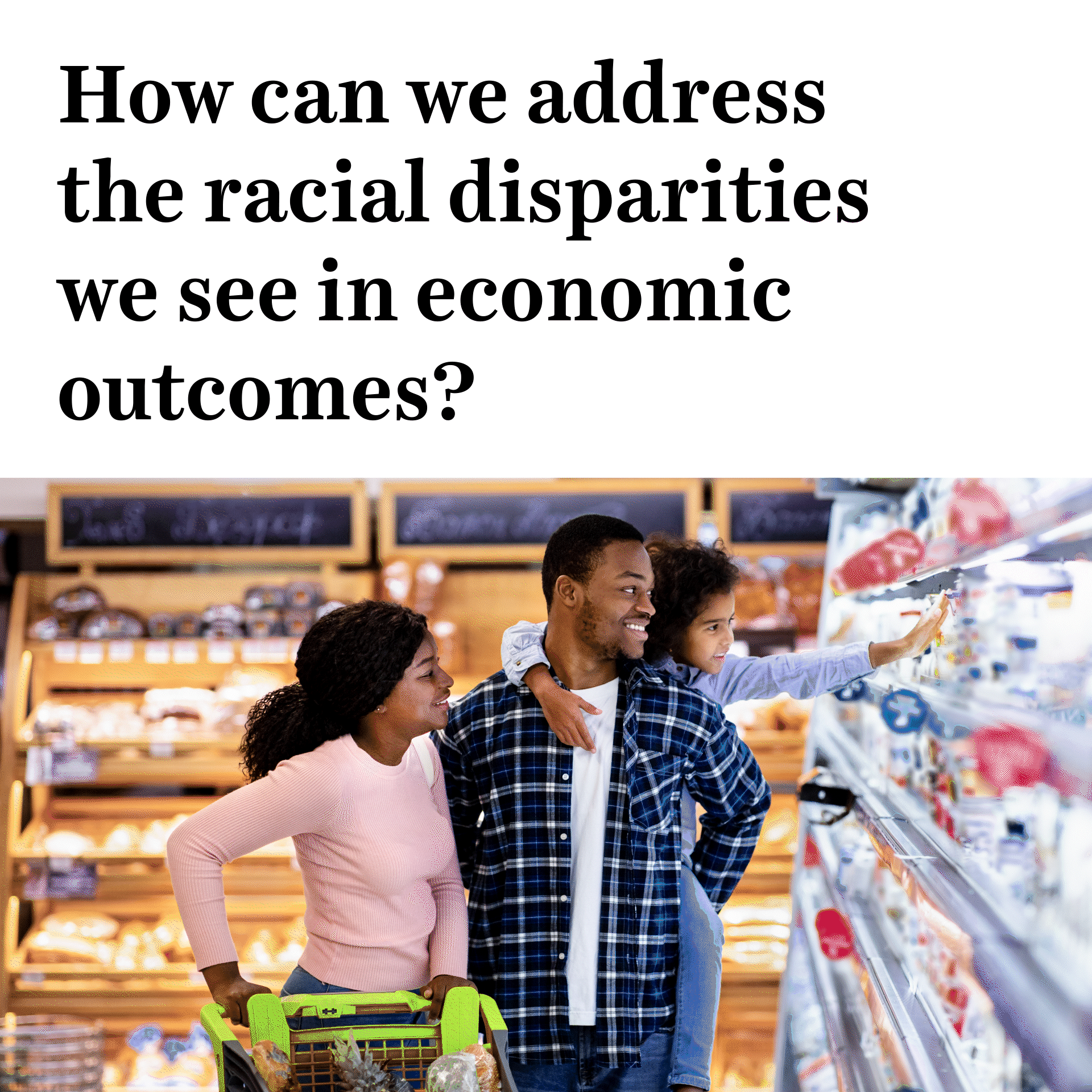Creating effective anti-racist economic research and policy requires thinking critically about the assumptions and norms that influence how we view the world, and thus the way we understand and interpret data or approach solutions to social and economic problems. This process begins with a willingness to revisit U.S. history or current events from a perspective other than the dominant or popular view.
This guide seeks to strengthen anti-racist research and policy work by challenging assumptions and norms and exploring emerging frameworks for data gathering and analysis. Rather than exhaustively surveying every important topic relevant to race and ethnicity and the economy, it serves as more of a thought piece. And it is coauthored by some of the leading voices on the myriad ways in which race and ethnicity have been used to assign advantage or disadvantage and to normalize racial and ethnic inequities.
The challenge for each of us is to understand how race shapes the American experience in countless intersecting, and sometimes contradictory, ways that can be hard to disentangle from the influence of other markers of identity or class, such as gender. Given those complexities, anti-racist economic research and policy often involves nuance, and is not easily boiled down into a simple checklist or a formulaic step-by-step guide. In fact, even the most well-meaning attempts to “check all the right boxes” can come across as superficial, performative, detached, or worst of all, counterproductive.
Guiding principles for anti-racist research, the ‘bodycam’ for racial economic injustice
 Phrases like anti-racist, racial equity, and racial justice have quickly become part of the standard lexicon of people and institutions grappling with what it really means to be diverse, equitable, and inclusive. These concepts, however, are more than just “woke” or “progressive” jargon. They are standards for making and sustaining meaningful changes that help to dismantle social, economic, and political structures that perpetuate racial inequality. Here anti-racist research plays a key role. Rather than simply reciting the problem of racial inequity, anti-racist research questions its causes, exposes its consequences, and proposes ways to resolve it. Economists and other social scientists use data and statistical methods to model the processes of human decision-making and evaluate the effects of policy decisions. Those same tools also help to expose how race is used to systematically assign access, opportunity, power, and economic resources exclusive of individual skill, ability, effort, or merit.
Phrases like anti-racist, racial equity, and racial justice have quickly become part of the standard lexicon of people and institutions grappling with what it really means to be diverse, equitable, and inclusive. These concepts, however, are more than just “woke” or “progressive” jargon. They are standards for making and sustaining meaningful changes that help to dismantle social, economic, and political structures that perpetuate racial inequality. Here anti-racist research plays a key role. Rather than simply reciting the problem of racial inequity, anti-racist research questions its causes, exposes its consequences, and proposes ways to resolve it. Economists and other social scientists use data and statistical methods to model the processes of human decision-making and evaluate the effects of policy decisions. Those same tools also help to expose how race is used to systematically assign access, opportunity, power, and economic resources exclusive of individual skill, ability, effort, or merit.The myth of race-neutral policy
 Race-neutral policies—such as the drive to eliminate affirmative action—are harmful for achieving true racial equity and justice. Race-neutral policies fail to reverse the persistent and in some cases widening gaps between economic outcomes for Black and white Americans that are largely due to racism that is entrenched within the very fabric of our customs, laws, systems, and institutions. We must acknowledge and tackle the barriers posed by structural racism with race-conscious policies that target the intersection of race, class, and gender. Only race-conscious policies—policies that may disproportionately help communities of color—can dismantle the structural barriers to prosperity, safety, and equity for Black Americans.
Race-neutral policies—such as the drive to eliminate affirmative action—are harmful for achieving true racial equity and justice. Race-neutral policies fail to reverse the persistent and in some cases widening gaps between economic outcomes for Black and white Americans that are largely due to racism that is entrenched within the very fabric of our customs, laws, systems, and institutions. We must acknowledge and tackle the barriers posed by structural racism with race-conscious policies that target the intersection of race, class, and gender. Only race-conscious policies—policies that may disproportionately help communities of color—can dismantle the structural barriers to prosperity, safety, and equity for Black Americans.Race and ethnicity in empirical analysis: How should we interpret the race variable?
 In trying to understand racial and ethnic groups well enough to write policy that improves their economic outcomes, we have to have a clear understanding of what “race” means in statistical analysis and how the effect of race is measured. Race factors into economic outcomes in complicated ways that even more sophisticated statistical models can’t capture. We need to carefully interpret the effect or predictive power of race in measured disparities—in both descriptive and more sophisticated statistical models—because our assumptions affect how we design policy to address racial disparities.
In trying to understand racial and ethnic groups well enough to write policy that improves their economic outcomes, we have to have a clear understanding of what “race” means in statistical analysis and how the effect of race is measured. Race factors into economic outcomes in complicated ways that even more sophisticated statistical models can’t capture. We need to carefully interpret the effect or predictive power of race in measured disparities—in both descriptive and more sophisticated statistical models—because our assumptions affect how we design policy to address racial disparities.Stratification economics: A moral policy approach for addressing persistent group-based disparities
 Conventional ideas for how to shrink racial disparities rely on methodological individualism—the notion that racial economic disparities can be eliminated by developing the “human capital” of disadvantaged groups (i.e., by “fixing Black people”). Stratification economics rejects that approach as misguided and doomed to failure. Rather, this explicitly moral research discipline recognizes that structural forces limiting opportunities for Black Americans were set up by white Americans to preserve their economic dominance. Thus eliminating racial disparities requires policy interventions that make structural changes to the way our economy functions. Stratification economics seeks to reduce disparities to improve the health and well-being of communities first and foremost, not to improve productivity.
Conventional ideas for how to shrink racial disparities rely on methodological individualism—the notion that racial economic disparities can be eliminated by developing the “human capital” of disadvantaged groups (i.e., by “fixing Black people”). Stratification economics rejects that approach as misguided and doomed to failure. Rather, this explicitly moral research discipline recognizes that structural forces limiting opportunities for Black Americans were set up by white Americans to preserve their economic dominance. Thus eliminating racial disparities requires policy interventions that make structural changes to the way our economy functions. Stratification economics seeks to reduce disparities to improve the health and well-being of communities first and foremost, not to improve productivity.Serving, organizing, and empowering communities of color: Best practices for aligning research, advocacy, and activism
 Improving economic opportunities and well-being in communities of color requires more than data and research. It requires grassroots groups that reject the transactional nature of electoral campaigns in favor of humility, deep listening, year-round engagement, and love. Only by questioning assumptions and organizing people around the issues they prioritize can you build trust and lasting change. For grassroots groups that want to truly advance policies that serve communities’ needs, there is much to take away from the lessons learned at Black Leaders Organizing Communities in Milwaukee.
Improving economic opportunities and well-being in communities of color requires more than data and research. It requires grassroots groups that reject the transactional nature of electoral campaigns in favor of humility, deep listening, year-round engagement, and love. Only by questioning assumptions and organizing people around the issues they prioritize can you build trust and lasting change. For grassroots groups that want to truly advance policies that serve communities’ needs, there is much to take away from the lessons learned at Black Leaders Organizing Communities in Milwaukee.Asian Americans and the anti-racist equity agenda: Contradictions and common ground
 Asian Americans are a growing, predominantly progressive political force in the United States. On average, they favor a bigger government with more services and support affirmative action—and cite universal health care, progressive tax reforms, gun control, and the environment as top concerns. However, stereotypes about Asian Americans, as well as a small but vocal contingent of Asian Americans working against anti-racist policies (such as affirmative action) complicate efforts to sustain multiracial coalitions working toward racial justice.
Asian Americans are a growing, predominantly progressive political force in the United States. On average, they favor a bigger government with more services and support affirmative action—and cite universal health care, progressive tax reforms, gun control, and the environment as top concerns. However, stereotypes about Asian Americans, as well as a small but vocal contingent of Asian Americans working against anti-racist policies (such as affirmative action) complicate efforts to sustain multiracial coalitions working toward racial justice.Multidimensional identities of the Hispanic population in the United States
 The Hispanic population in the United States is a large and diverse group of people with multidimensional identities. Existing survey instruments pose critical limits on research into this population and thus impact resulting policies. While the principle of racial and ethnic self-identification is important to respect and preserve, designing better surveys with more objective indicators of racial and ethnic background would provide a clearer picture of diverse subgroups and how they fare economically compared with one another and with other demographic groups. This is a critical step that would enable researchers to advance the collective understanding of the Hispanic population and thus allow policymakers to better address the challenges Hispanic people in the United States face.
The Hispanic population in the United States is a large and diverse group of people with multidimensional identities. Existing survey instruments pose critical limits on research into this population and thus impact resulting policies. While the principle of racial and ethnic self-identification is important to respect and preserve, designing better surveys with more objective indicators of racial and ethnic background would provide a clearer picture of diverse subgroups and how they fare economically compared with one another and with other demographic groups. This is a critical step that would enable researchers to advance the collective understanding of the Hispanic population and thus allow policymakers to better address the challenges Hispanic people in the United States face.The power of self-determination in building sustainable economies in Indian Country
 Tribal governments are a significant part of the national economy, thanks to a policy shift toward tribal self-governance that ushered in an era of economic development, led by tribal gaming. Yet the economic and cultural shocks that deprived Native Americans of their livelihoods and social infrastructure for so long are still affecting Indian Country. To effectively address the economic and social challenges faced by Native Americans and their communities, policymakers and researchers must understand that tribal self-determination through self-governance is the only policy that produces positive results, and that further advances for Native Americans require tackling bureaucratic barriers such as tribes’ incomplete authority to put their lands to good and productive use, their inability to collect taxes to pay for government operations, and discriminatory higher costs for accessing capital.
Tribal governments are a significant part of the national economy, thanks to a policy shift toward tribal self-governance that ushered in an era of economic development, led by tribal gaming. Yet the economic and cultural shocks that deprived Native Americans of their livelihoods and social infrastructure for so long are still affecting Indian Country. To effectively address the economic and social challenges faced by Native Americans and their communities, policymakers and researchers must understand that tribal self-determination through self-governance is the only policy that produces positive results, and that further advances for Native Americans require tackling bureaucratic barriers such as tribes’ incomplete authority to put their lands to good and productive use, their inability to collect taxes to pay for government operations, and discriminatory higher costs for accessing capital.Racial and ethnic disparities in the United States: An interactive chartbook
 This interactive chartbook provides a statistical snapshot of race and ethnicity in the United States, depicting racial/ethnic disparities observed through population demographics; civic participation; labor market outcomes; income, poverty, and wealth; and health. The chartbook also highlights some notable intersections of gender with race and ethnicity, including educational attainment, labor force participation, life expectancy, and maternal mortality. The findings are bracing, as they show how much more work we need to do to address longstanding and persistent racial inequities.
This interactive chartbook provides a statistical snapshot of race and ethnicity in the United States, depicting racial/ethnic disparities observed through population demographics; civic participation; labor market outcomes; income, poverty, and wealth; and health. The chartbook also highlights some notable intersections of gender with race and ethnicity, including educational attainment, labor force participation, life expectancy, and maternal mortality. The findings are bracing, as they show how much more work we need to do to address longstanding and persistent racial inequities.

